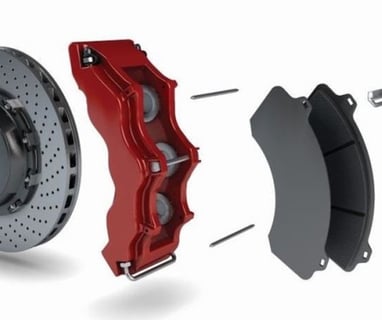How to change brake pads?


Changing brake pads on a vehicle involves working with critical safety components, so it's essential to follow proper procedures and take necessary precautions. Here's a general guide to changing brake pads, but keep in mind that specific steps may vary based on the make and model of your vehicle. If you're not confident in your mechanical skills, it's recommended to seek professional help.
Note: This guide assumes you have the necessary tools, a safe working environment, and a basic understanding of vehicle mechanics. If you're unfamiliar with any step, consider seeking help from a qualified mechanic.
Materials and Tools You'll Need:
-New brake pads (make sure they're compatible with your vehicle)
-Lug wrench or socket set
-Jack and jack stands
-C-clamp or brake caliper tool
-Wrench set
-Brake fluid (if necessary)
-Gloves, safety glasses, and basic hand tools
Step-by-Step Guide:
1. Safety Precautions:
Park your vehicle on a flat, stable surface.
Engage the parking brake.
Put on safety glasses and gloves.
2. Prepare the Vehicle:
Loosen the lug nuts on the wheel of the corner you'll be working on (don't remove them yet).
Lift the vehicle using a jack and secure it with jack stands.
3. Remove the Wheel:
Completely remove the lug nuts and take off the wheel.
4. Access the Brake Components:
Locate the brake caliper (it's the component that clamps onto the brake rotor).
If your vehicle has a retaining clip or pins holding the brake pads, remove them.
5. Remove the Caliper:
Use a wrench to remove the caliper bolts.
Gently slide the caliper off the rotor.
Hang the caliper using a wire or bungee cord to avoid putting stress on the brake line.
6. Replace the Brake Pads:
Slide out the old brake pads from the caliper bracket.
Use a C-clamp or caliper tool to gently compress the caliper piston back into the caliper housing. This creates space for the new, thicker brake pads.
7. Install the New Brake Pads:
Slide the new brake pads into the caliper bracket.
Reattach any retaining clips or pins that were removed earlier.
8. Reattach the Caliper:
Carefully place the caliper back over the brake pads and rotor.
Reinsert and tighten the caliper bolts.
9. Reinstall the Wheel:
Put the wheel back onto the wheel hub.
Screw on the lug nuts by hand.
10. Lower the Vehicle:
Carefully lower the vehicle off the jack stands using the jack.
11. Tighten Lug Nuts:
Use a crisscross pattern to tighten the lug nuts to the manufacturer's recommended torque specifications.
12. Test the Brakes:
Before driving, gently press the brake pedal a few times to ensure proper brake pad seating.
Remember, this is a simplified guide and specific steps can vary between vehicle models. Always consult your vehicle's manual and follow manufacturer recommendations. If you're unsure about any part of the process, it's safer to consult a professional mechanic. Brake maintenance is crucial for safety, so ensure the job is done correctly.
